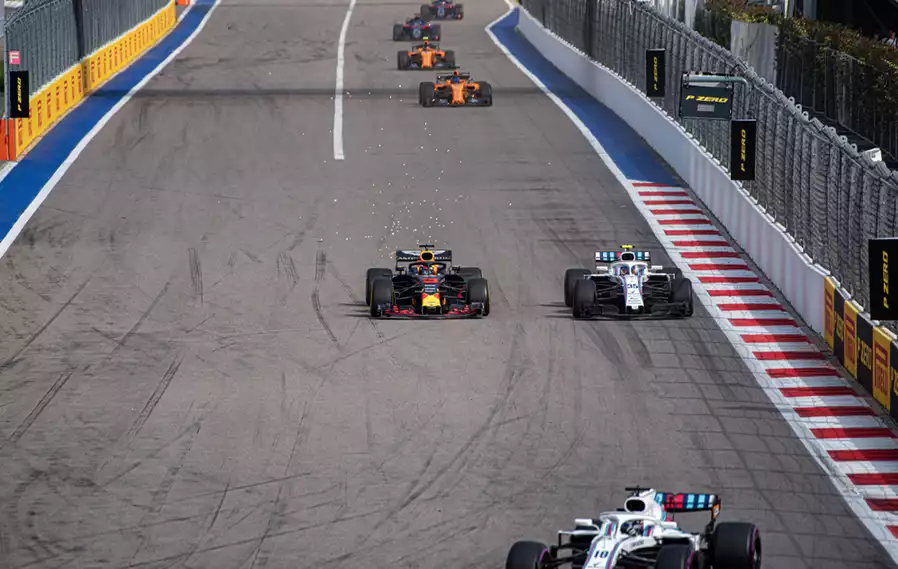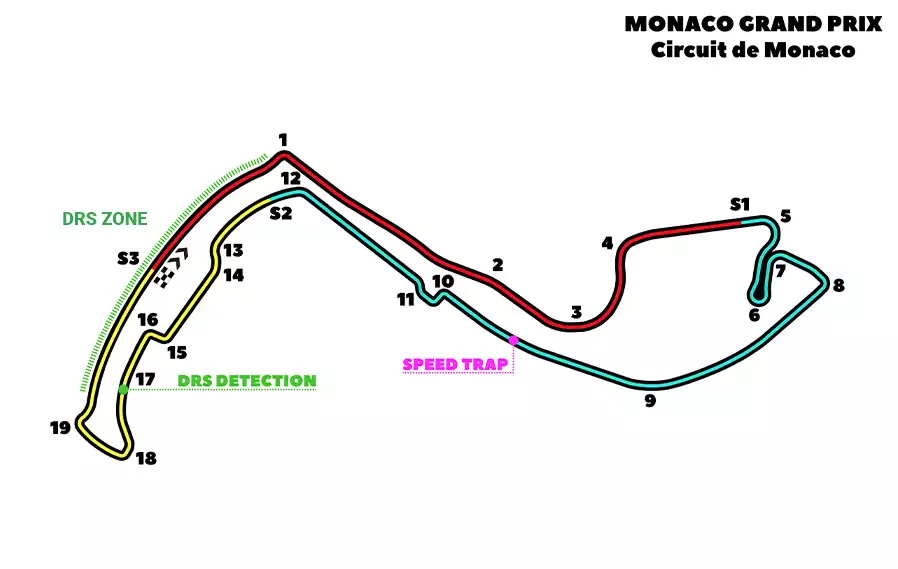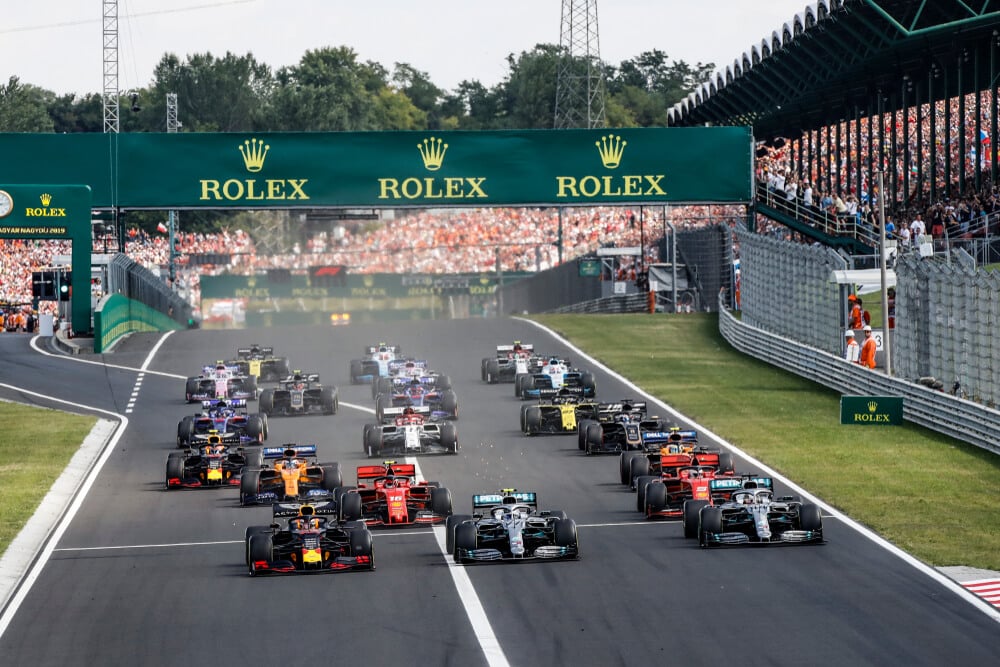Aerodynamics is a very interesting concept that is widely used in vehicles. One such part of the vast aerodynamic field is the DRS (Drag Reduction System). It isn’t something new, and its applications can be clearly seen on aircraft.
However, using the DRS system on the F1, engineers and F1 teams have managed to make the much popular sports race more exciting and enthralling.
Despite its regular occurrences in the F1 commentary and news, DRS is a term still abstruse to many.
This is why, in this article, we will be going into the depths of the DRS system, explaining what it means, its uses, rules, and much more.
Table of Contents
Watch this video to undertsand how DRS works in Formula One.
What is DRS (Drag Reduction System) in F1?
The Drag Reduction System is a controllable rear wing on an F1 car that helps the driver to increase the car’s speed and overtake their rival car. DRS is based on simple aerodynamics and has been subject to different controversies throughout its inception in 2011.
Key takeaways
- DRS stands for Drag Reduction System and was introduced in 2011 to reduce the effects of dirty air.
- Dirty air makes the car lose grip and reduces its speed.
- DRS is a flap on the rear wing of the F1 car that reduces the drag effect.
- Reducing the drag effect can help the F1 car increase its speed by twelve kilometers per hour on a straight track.
- The DRS is manual and is operated by the driver.
- The DRS can only be used in the specified zones, the DRS zones, designated by the FIA.
- The DRS zones have a detection point and an activation point. The detection point is where the distance between the two cars is measured. The activation point is where the driver can activate the DRS of his car.
- If there is a one-second distance between two cars, the car that is chasing can activate its DRS system.
- DRS is often perceived as an artificial system that is unfair to the driver and the race itself. This is because the use of DRS has lost the thrill of unexpected overtaking.

Photo showing a overtaking done by DRS (this image shows the moment after the wing closed).
Understanding DRS
The Drag Reduction System was introduced back in 2011 after the unfortunate events of the 2010 Abu Dhabi Grand Prix. This series of events forced F1 engineers to come up with a system that reduces the effect of dirty air thrown by the leading car onto the car just behind it.
The dirty air is the turbulent air thrown by the leading car, which does not let the car trailing behind it generate much downforce.
Driving through dirty air is very difficult and unfair for the F1 driver chasing the lead car. Plus, dirty air does not let the car generate as much downforce as generated by the leading car. This means that the trailing car will have less grip and will lose its speed.
Theoretically, an F1 car can drive upside down due to the downforce that the car is able to generate.
When driving from the corners back into the straight, the gap between the chasing and the leading car increases because of the decrease in speed of the chasing car around the corners.
It was because of this reason that the DRS was introduced. DRS helps increase the speed of the car and reduce the effect of dirty air, making overtaking much simpler.
However, DRS is not a magic button to increase the car’s speed, and it can’t be used everywhere on the track.
How does DRS work?
The rear wing on an F1 car consists of an adjustable flap that could be opened up by the driver if certain rules, which are discussed below in the article, are met. The flap decreases the surface area of the wing. This lets the air flow more freely from over the wing, which in turn reduces the aerodynamic drag, increasing the speed of the car.
DRS can be used only in the DRS zones. The drivers are informed by their team as to when they can use the DRS by flashing the light on their steering wheels.
The driver will then open the flap on the rear wing (the DRS system) by pressing a button present on the steering wheel.

What is a DRS zones?
F1 has specific zones in which the driver is allowed to activate their DRS system. However, the number of times a DRS can be activated is not specified, meaning that the driver can use the system as many times as the situation allows him to do.
Each Grand Prix event has one to three DRS zones in which the DRS can be activated. Each zone has a detection point and an activation point.
The start of the DRS zone is marked with a line, the detection point, from where the distance between two cars is measured.
If the distance is deemed fit according to the rules set by the FIA, the driver can activate the DRS at the activation point of the zone.
Gaining up to 12 km/h extra speed
While decelerating or braking when taking corners, the DRS system is deactivated automatically. This is so because the DRS is only effective along straights and not on corners.
The DRS reduces the drag force of the car, which is much required during cornerings for the F1 car.
On a straight track, when the driver opens the flap on the rear wing of the F1 car, the surface area of the wing reduces.
This means that the air flows through the hole created by the flap, increasing the speed of the car by twelve kilometers per hour.
Read more about how clean and dirty air affects the slipstream when overtaking for Formula 1 cars.
Cons of using the DRS system
The advantages of using the DRS in F1 are well known by the people watching F1 races. However, despite all the work that the FIA put into devising a system to reduce the effects of dirty air, many fans and drivers are still not happy with the DRS.
DRS is perceived as an artificial means of overtaking and gaining speed in the F1 race. Fans speculate that the DRS has made the race ‘not real’ and it often preempts the driver to perform real overtaking.
Most drivers wait until they get into the DRS zone to overtake their rival car, which has sanitized the thrill and excitement of the F1 race.
Plus, many fans are also not happy with the fact that the car leading the position is left defenseless and is not allowed to use the DRS system to barricade its position.
Most drivers wait until they get into the DRS zone to overtake their rival car, which has sanitized the thrill and excitement of the F1 race.
Watch this video to undertsand how a DRS train works.
Another reason why DRS is not much appreciated by the fans is the formation of the DRS train. A DRS train is formed when a slow leading car is driving defensively, which is followed by several other cars within one-second distance from each other.
In this case, the DRS effect of all the cars is nullified as every single one of the cars is using the DRS. This makes overtaking very tedious and frustrating.
The only way one can get out of the DRS train is that the first chasing car behind the lead tries to overtake it. Then each of the cars behind it can try and do the same to get out of this train.
DRS rules in Formula 1
DRS is the only movable part of the F1 car that the driver can change during the F1 race. However, in order to use it, the driver has to abide by some rules that have been set by the FIA for the use of the DRS system.
1-second rule
The DRS can only be activated if the car in the front is just one second away from the car following it. When an F1 car enters the detection point in the DRS zone, the detector measures the distance between both cars. If the distance is according to the rules set by the FIA, that is, both should be one second away from each other, and a signal is sent to the driver. The electronic signal informs the driver whether or not he can activate the DRS.
Other rules
Apart from the one-second rule for the use of DRS, there are some more rules set by the FIA for its use.
The DRS can only be enabled in the designated DRS zones and not in any other parts of the track.
The DRS can only be activated once the driver has completed two laps after the start, restart, or safety period of the Grand Prix event. During unsafe conditions, such as rainfall or accidents, the driver is not allowed to use the DRS system unless stated by the Race Director.
The DRS can not be used by the leading car to gain an advantage over the car following it unless they are one second away from the car in front of them.
Frequently asked questions about Downforce
Is DRS automatic in F1?
What is DRS short for in F1?
Who controls DRS in F1?
Can an F1 driver use DRS in qualifying?
Conclusion
DRS was introduced by F1 engineers to reduce the effect of dirty air and aid cars within one second from each other to overtake. This increased the chances of wheel-to-wheel racing, which made the game more interesting and exciting.
However, the controversies that surround the DRS, such as the driver in the front not getting an equal advantage to defend his position, have put this system in a difficult place. Most of the fans have deemed this system to be unfair, despite its advantages.
Thanks to the constant research and development by engineers, they have designed cars that are able to reduce the effects of dirty air for the Grand Prix events from 2022. Hence, it is suspected that by 2026, with the help of a few more changes, the system of DRS will be completely weeded out.
Article sources
- https://f1.fandom.com/wiki/Drag_Reduction_System#:~:text=It%20may%20sound%20counter%2Dintuitive,grip%2C%20for%20optimum%20cornering%20capabilities
- https://www.thesun.co.uk/sport/6704754/f1-drs-drag-reduction-system-explained-verstappen/#:~:text=It%20is%20used%20to%20reduce,three%20to%20help%20to%20overtake
- https://www.independent.co.uk/f1/what-is-drs-f1-overtaking-b2104584.html
Learn more about Formula One
Want to learn more about F1? Then visit our Formula 1 glossary and dictionary.



